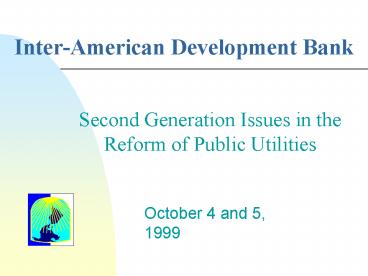InterAmerican Development Bank - PowerPoint PPT Presentation
1 / 18
Title:
InterAmerican Development Bank
Description:
Changes in technology and/or demand, natural phenomena. Disputes and Renegotiations ... Different train operators using the same existing rail system ... – PowerPoint PPT presentation
Number of Views:42
Avg rating:3.0/5.0
Title: InterAmerican Development Bank
1
Inter-American Development Bank
- Second Generation Issues in the Reform of Public
Utilities
October 4 and 5, 1999
2
Introduction
- Post-Privatization Renegotiations and Disputes
- Open Access to networks
- Flaws in the Initial Reform Process
- Alternative Solutions
- Challenges Ahead for the Consolidation of Reforms
3
Organization of the Discussion
- The Initial Reform Process
- The Role of the IDB
- Post-Privatization Disputes and Renegotiations
- Promoting Competition in Public Services
- Final Remarks
4
The Initial Reform Process
- Reform of Infrastructure Services Aimed at
Avoiding Inefficiency Trap - From vertically integrated and publicly owned
monopolies - To a model that
- Promotes PSP and competition
- Creates conditions for economic efficiency
- Translates efficiency gains into improvements for
society
5
The Initial Reform Process
- Key Elements
- Promote Competition
- IN the market in competitive segments of the
industry - FOR the market in the natural monopoly segments
of the industry - Create Appropriate Legal and Regulatory Framework
- Ensure competition when possible
- Set prices and quality levels
- Protect producers and consumers
6
The Role of the IDB
- Promote and Support Reforms
- Adopting a policy on public utilities that
promotes competitive reforms and proper
governance - Developing new financial and non financial
instruments appropriate to the new situation
7
The Role of the IDB
- Policy Recommendations
- Separation of roles of policy formulator,
regulator and entrepreneur - Sector structure that favors efficiency and
maximizes the scope of competition - Adoption of a sound and adequate regulatory
regime - Appropriateness of institutional vehicles for
regulation - Adequacy of the legal framework
- The adoption of governance modes that provide
efficiency incentives for management
8
The Role of the IDB
- Financial Support
- Public and Private Sector Loans
- 1.9 billion in average annual financing for
infrastructure in 95-98 - Increased proportion of loans to the private
sector ( 580 million in 1998) - Guarantees to mitigate regulatory and political
risks - Technical assistance to the public sector to
- Design sector strategies
- Design and implement regulatory frameworks
- Strengthen regulatory institutions
- Grants (MIF) for implementing reforms
9
The Role of the IDB
- What next?
- Reforms began a decade ago
- Time is right for looking into the following
questions - Was the market structure appropriate?
- Was the regulatory and legal framework
appropriate ? - Did the regulatory institutions behave as
expected ? - What should be done to ensure that reforms spread
their benefits to society as a whole ?
10
Disputes and Renegotiations
- The analysis is focused on post-privatization
disputes and renegotiations because - Disputes
- Argentina, Colombia, Chile
- Investment programs have been delayed
- Tariff trends have differed from expectations
- Renegotiations
- Impact on consumers and private operators
- Threats to the financial community
11
Disputes and Renegotiations
- Origins of Disputes
- Award Process
- Lack of competition lack of clarity
- Market Structure
- Lack of competition
- Vertical and horizontal integration
- Regulatory Framework
- Ambiguities in contracts and law
- Deficient design
- Omissions
12
Disputes and Renegotiations
- Origins of the Disputes
- Tariff System
- Problems with tariffs, subsidies, investment
- Adjustment mechanisms
- Inefficient and unsustainable price structure
- Lack of specificity lack of flexibility
- Regulatory Institutions
- Lack of independence, resources and/or expertise
- Unanticipated Events
- Changes in technology and/or demand, natural
phenomena
13
Disputes and Renegotiations
- Settlement of Disputes
- Procedures
- Regulator ruling arbitration the courts
- Role of Different Institutions
- Consequences
- Economic efficiency
- Financial equilibrium
- Transfers among different agents
14
Promoting Competition
- The Reform Promoted Competition in Areas that
were Considered Natural Monopolies - Generation of electricity
- Production of natural gas
- Non-local telephony
- Different train operators using the same existing
rail system - Did the benefits from competition reached
consumers? - More competition will increase efficiency
15
Promoting competition
- Regulating Access is Crucial
- Create the Proper Conditions for Entry Into the
Competitive Segment Without - Inducing excessive entry
- Expropriating previous investments
- Discouraging future investment in the monopolized
part of the industry - Generating inefficient bypass.
16
Promoting competition
- Success in Regulating Access
- The effects of existing legislation
- Ways in which prices and terms of access are
determined - How disputes over access are resolved
- Identifying pitfalls (and possible solutions) in
existing arrangements
17
Final Remarks
- Identify Main Pitfalls of Reform and Possible
Solutions - Day One
- Key elements to reduce the conflicts and disputes
- Procedures for increasing the efficiency of
settlement processes - Actions to minimize the negative impact of
disputes on the economic efficiency, social
perception and the financial community - Day Two
- Consumer benefits from widening the scope of
competition in several sectors - Key and uncomplicated components for effective
open access to network regulations
18
Final Remarks
- Countries have made considerable efforts remove
public services from the inefficiency trap
through PSP and competition - The IDB has supported the process
- Appropriate solutions to the problems resulting
from the initial reform are needed to consolidate
the process

